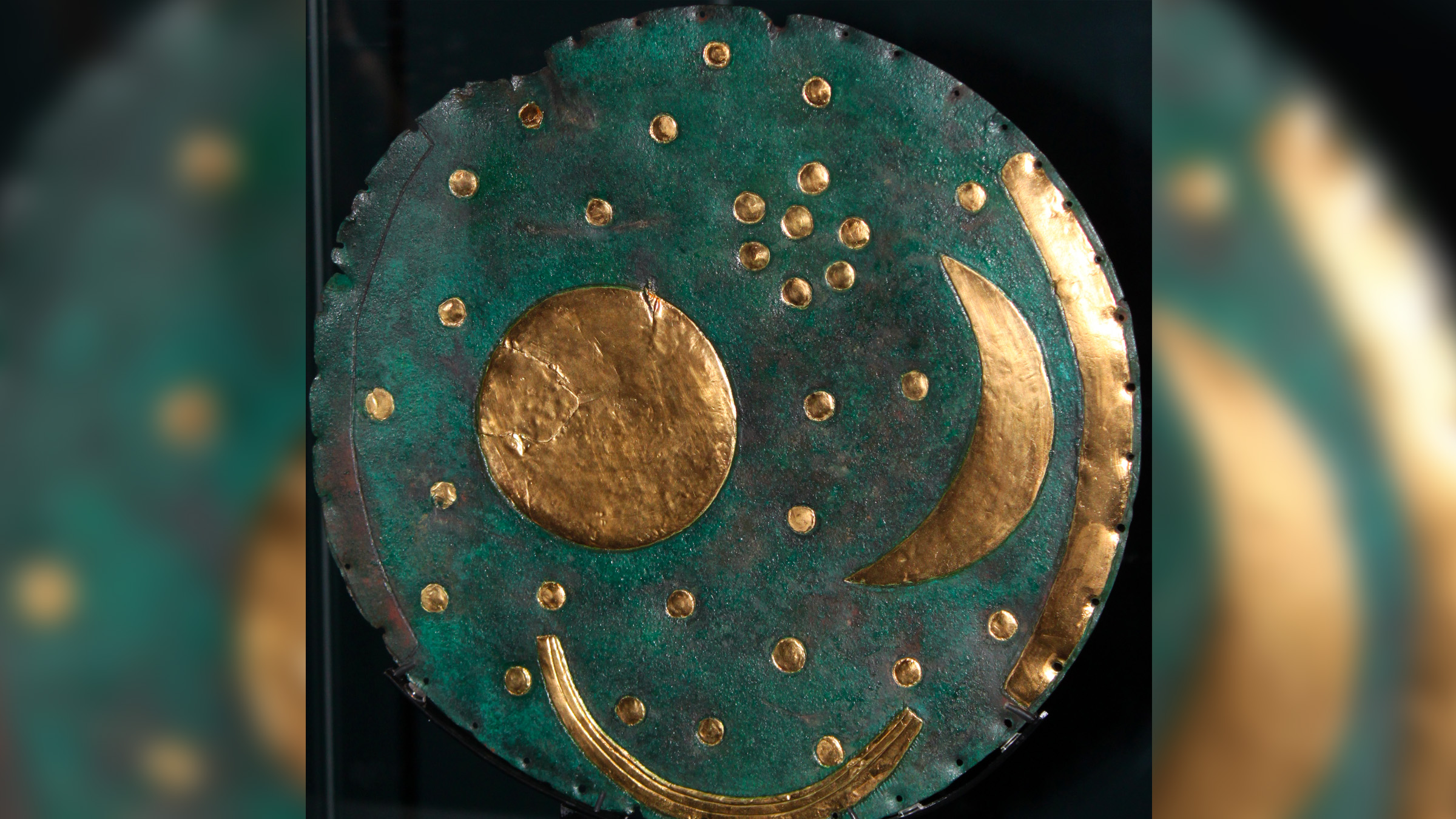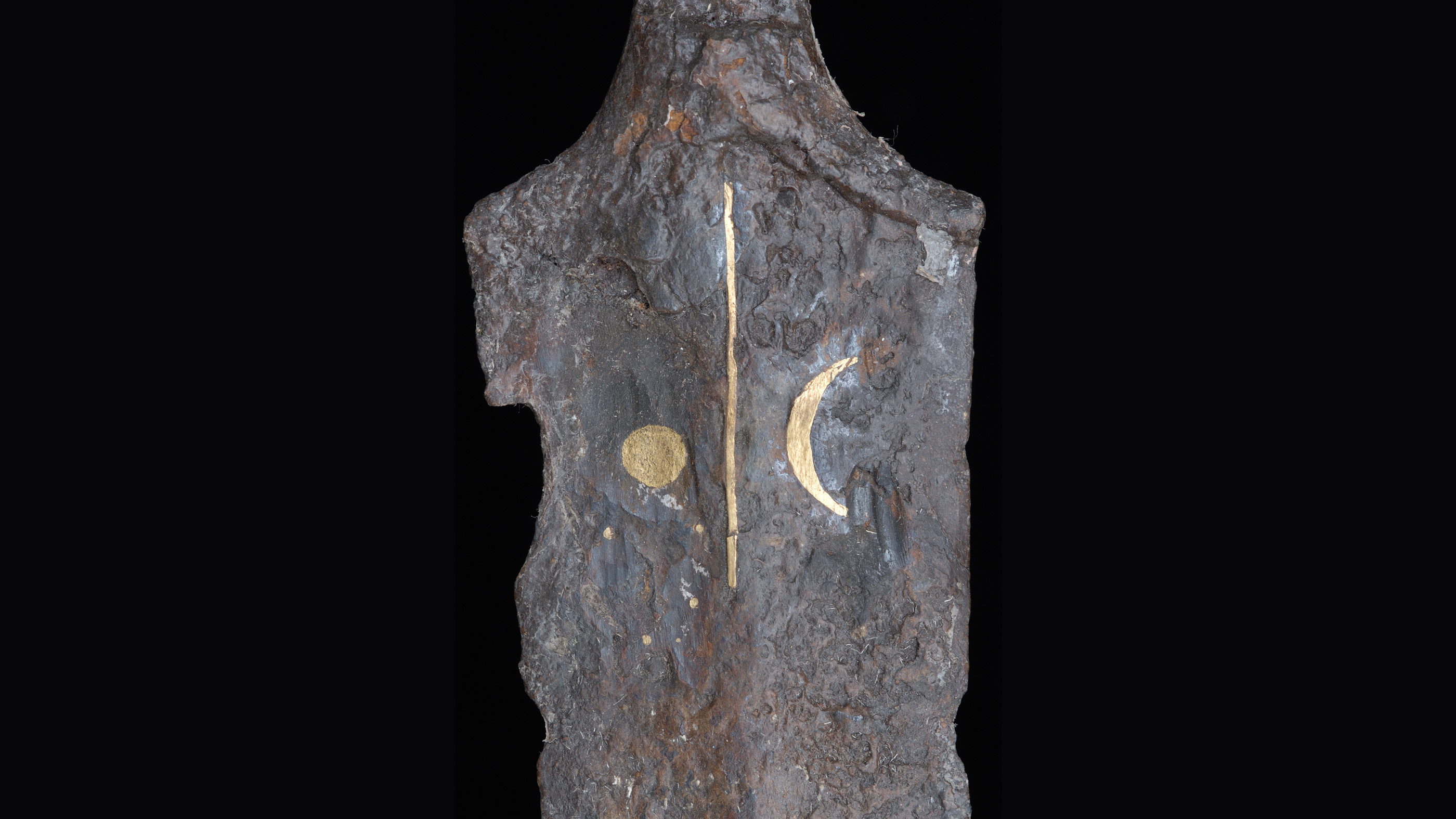Study casts doubt on 'sky disk' thought to be oldest representation of the heavens

One of Germany's most famous ancient artifacts may not be what it seems, if a new study is to be believed.
Fierce debate over the Nebra Sky Disk has been reignited by a new study that suggests it is at least 1,000 years younger than previously thought, and probably doesn't have any of the elaborate meanings proposed for it.
The 12-inch-wide (30 centimeters) bronze disk inlaid with gold circles, arcs and crescents was reportedly unearthed in 1999 near the town of Nebra, in Germany's Saxony-Anhalt state.
It was widely hailed as one of the most stunning ancient artifacts ever found. But controversy has surrounded it since its discovery.
Related: 30 of the world's most valuable treasures that are still missing
Experts have long debated where the disk originated and what meaning, if any, it holds; some have even declared it is fake (and created very recently) — although scientific tests suggest it's an authentic artifact that may date from Europe's pre-Celtic Bronze Age, up to 3,800 years ago.
If that dating is correct, then the Nebra Sky Disk is the oldest-known representation of the heavens anywhere in the world, said Jan-Heinrich Bunnefeld, an archaeologist at Saxony-Anhalt's State Museum for Prehistory in the city of Halle, where the disk is now on display (The next oldest is an ancient Egyptian star map on the ceiling of a tomb from about 3,500 years ago).
Get the world’s most fascinating discoveries delivered straight to your inbox.
"The Nebra Sky Disc features the oldest concrete depiction of cosmic phenomena," Bunnefeld told Live Science in an email. "It is a key find, not only for the discipline of archaeology, but also for astronomy and the history of religions."
Ancient artifact
But a new study casts doubts on the origins and meaning of the Nebra Sky Disk.
Writing this month in the journal Archäologische Informationen, University of Munich archaeologist Rupert Gebhard and Rüdiger Krause, an archaeologist at Goethe University in Frankfurt, argue that the artifact could not have been unearthed at the location near Nebra, according to a statement.
That also means the sky disk probably isn't from the Bronze Age at all. In addition, a new examination of its iconography suggests the artifact dates to the period of the Celtic Iron Age between about 2,800 and 2,050 years ago, the researchers wrote.
The study has created outrage in parts of the archaeological scene in Germany, where the Nebra Sky Disk is considered a national treasure and an emblem of early European civilization — and where any challenges to its provenance or authenticity are aggressively confronted.
"It's like Beethoven's Ninth," Gebhard told Live Science, referring to the composer's famous symphony, a nationally revered symbol of German achievement.
"That makes it difficult for me … you can understand that people are not very happy about this."
Bronze Age hoard
The biggest reason the new study casts doubt on the sky disk's provenance is that scientific evidence suggests it was not part of a hoard of Bronze Age axes, swords and bracelets allegedly unearthed by treasure hunters near Nebra in 1999, although it was initially thought to be, Gebhard said.
The collectors sold the disk and hoard to a black-market collector for around 70,000 German marks ($42,000) and it was sold on for up to a million German marks ($600,000), until police recovered the hoard in 2002 and handed it over to state archaeologists.
A court found the two treasure hunters guilty in 2005 for the illegal excavation, sentencing the pair to several months in jail.
Statements made by the treasure hunters in their attempts to appear to be cooperating with authorities explains the resulting confusion about the location of the artifacts, Gebhard said.
Related: 10 historical treasures the world lost in the last 100 years
But archaeological evidence, soil analysis and studies of trace isotopes (variations of an element with different numbers of neutrons) in the metals of the disk show it must have been found somewhere else, and then sold as part of the hoard from Nebra: "If you go back to the basics, then you won't find any argument that these objects belong together," he said.
Gebhard hopes the treasure hunters will eventually explain where they actually unearthed the Nebra Sky Disk, information that would cast new light on its origins.
"I think our article now brings some movement in this story," he said. "I hope it will be the first step to get some information about the original site."
Disputed origins
Past analysis of the construction of the disk and the metals that were used shows the Nebra Sky Disk was made in several phases. Its creators first added a central group of gold stars, which have been interpreted as the Pleiades, and a large gold circle and crescent, which have been interpreted as the full and crescent moon.
They later rearranged some of the gold stars, also adding two "horizon" arcs to the edges of the disk which may show the movement of the sun on the winter and summer solstices.
Related: Amazing astronomy: Victorian-era illustrations of the heavens
During a later phase, the artists added an arc near the bottom edge of the disk, which was previously interpreted as a "solar boat" carrying the sun through the sky.
Proponents of the disk's Bronze Age origins say the artifact represents a sophisticated understanding of astronomical phenomena as well as the intricacies of religious thought at the time.
Archaeologists at the Saxony-Anhalt State Museum for Prehistory in Halle, who support the Bronze Age dating, insist the latest study is wrong. They say some of the soil samples suggest the sky disk could have been part of the Nebra hoard, while chemical analysis of its metals establish its earlier date.
"Gebhard and Krause are ignoring important publications and quoting only those facts that seem useful to underline their theory," deputy state archaeologist Alfred Reichenberger said in a statement. "The theory of an Iron Age date for the Nebra Sky Disc is demonstrably incorrect."
But Gebhard said the iconography of the sky disk shows it was probably made in the Iron Age, possibly by peoples in the north of Germany who were strongly influenced by the Celtic civilization farther south.
Iron Age swords and other objects from the region are also decorated with symbols of the moon and stars that reflect the symbolic importance of the night, he said.
Any new interpretations of the Nebra Sky Disk would have to account for the uncertainty of its origins, Gebhard said. "We just have to start at the very beginning again."
Originally published on Live Science.
Tom Metcalfe is a freelance journalist and regular Live Science contributor who is based in London in the United Kingdom. Tom writes mainly about science, space, archaeology, the Earth and the oceans. He has also written for the BBC, NBC News, National Geographic, Scientific American, Air & Space, and many others.




